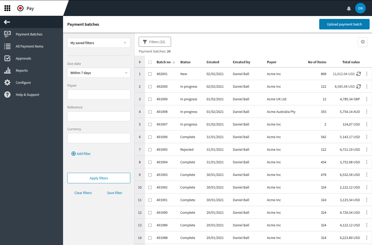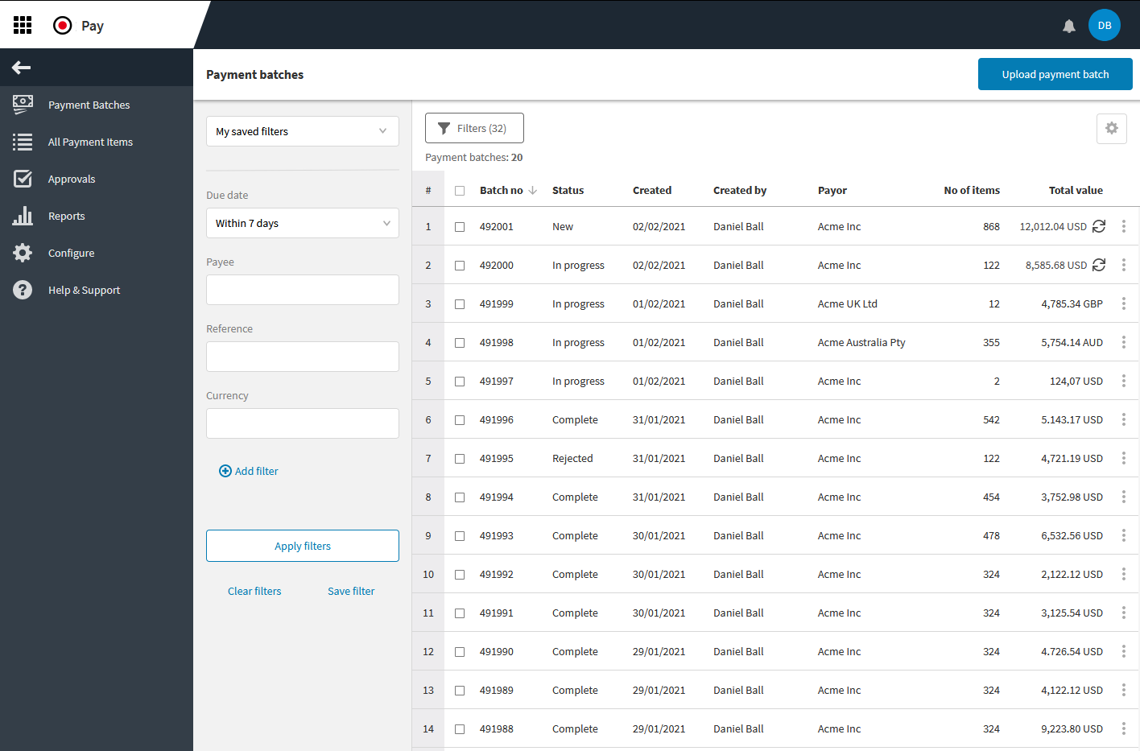

What is batch payment processing?
A batch payment is a grouping of payments that are paid out from the same bank account. Companies may choose to process these group payments manually or through automated means.
Companies that rely on manual payment processing methods face increasingly difficult issues.
Time marches on, and the world around us – including customers, suppliers, and business partners increasingly rely on electronic invoicing and payment methods. Businesses that fail to keep up with the times will find that their processes slow to a crawl.
Another factor that plagues companies is the complexity of doing business as they scale up. Over time, a company will increase its throughput, which means an ever-larger number of items that must be processed for payment.
These are just a couple of reasons that most companies are looking for ways to expand their AP automation methods.
One study by PYMENTS showed that 98% of surveyed business leaders believed automation techniques like batch processing of payments would improve their speed of doing business1.
1 “The Data Point: 98% of Businesses Say Automated AP Speeds Payables, Fuels Growth.” Pymnts.com, PYMNTS, 24 May 2022.
Benefits of batch payment processing
AP teams will benefit from switching to an automated batch payment process. Consider some valuable changes driving this move to a more stable workflow.

Time efficient
Manual workflows equate to a need for a standard payment timeline. AP teams are hands-on and must manage the process manually, which takes as long as it takes.
An automated AP solution will take payments and create a standard timeline for the process. This simplification creates a more structured environment for accounts payable and improves vendor relationships when they get regular, on-time payments.
Cost effective
In the business world, time is money, and having a single transaction reduces individual transactions on banking statements that must be reconciled one at a time.
Automation techniques allow AP professionals to handle more payments as the company grows without additional staff.


Fewer errors
Errors like duplicate payments create additional work and cost for AP staff. Repetitive data entry allows errors or fraudulent activity to creep in.
An automation platform can introduce safeguards that protect against risk. Payment systems are protected behind password-secure authentication pages. Standard practices such as dual authorizations on payments over a certain level can be enforced.
Easier tracking
Automated payments supported by electronic supporting documents, such as invoices and receipt of goods statements, can easily be cross-checked.
One of the benefits of digitizing processes is that AP departments manage electronic data, which can be useful to the company.
Data can flow out to information dashboards that track the business’s key performance indicators so that it becomes visible and actionable, leading to better decision-making.

Best practices when batch payment processing
Automated batch payment processing follows a standard progression of steps:
To ensure this process runs smoothly, accounts payable staff must work on digitizing as many of their routine steps and automating them. Medius provides tools that address every step of the invoice-to-pay workflow.
Manual vs. automated batch payment processing
Manual
Manual processes can cost more money and are time-consuming for an AP department. This is especially true when multiple payment types are introduced, requiring separate workflows.
For example, paper checks will need to be signed, and ACH transactions may require a visit to the bank to set up.
Data entry into the journal and manual cross-checking of each payment line item creates more bottlenecks.
Then the accounts payable staff must repeat the process the next week in a never-ending cycle that will only grow over time and usually necessitates additional AP staff.
Automated
On the other hand, automated batch payments, when part of an overall push toward AP automation, can simplify the workflow.
A standard payment timeline is created with improved security measures and strengthened vendor relationships because partnering companies are getting paid on time.
The Association for Financial Professionals found that 33% of business-to-business payments in the US and Canada continue using paper checks2. But 3 in 4 respondents found their business positively impacted by faster payments.
2 AFP, 2022, 2022 AFP Digital Payments Survey.
Find out what Medius can do to support your company's efforts to streamline payment processes.
Frequently asked questions about batch payment processing
Batch processing of payments works well for multiple transactions that group naturally. Payroll, end-of-month reconciliations, or settling overnight transactions can all be implemented through a batch process.
Routine and smaller transactions that can be handled in bulk or less time-sensitive will often be better handled through an automated accounts payable batch process.
High-dollar, quick turnaround or mission-critical deals may require manual processing instead of waiting for the next batch process.
There are typically a few necessary steps to implement batch payment processing. Having the right AP software in place is necessary, and appropriate attention must also be given to regular training of accounts payable staff.
Batches of potential invoices, adjustments, and payments are created and reviewed for possible mismatches. These are prepared for submission as a group to save time on fees and processing work.
The batches are posted in the automation software and linked to the general ledger in the accounting system.
Batches are posted in journals and other reports for audit purposes and to ensure accuracy.
Because batch processing involves a set timeline, overly important transactions may not be compatible with this payment method.
There may be a natural delay or lag when order information changes rapidly. There is an increased risk that batch data may need to be updated between the time it is approved and processed.
If AP staff do not keep good records, key processing measurements, such as the time it takes for an order to export, may be skewed by the time delay from the batch payment process.
Several factors will affect the time it takes to process a batch of payments.
Some processors have longer wait times, and the banking institution may introduce additional bottlenecks. Typically, a batch takes 1 to 3 days to complete the entire process from start to finish.
Many payment processors support international payments, but because of the different standards present in separate countries – not to mention currency differences – it may introduce additional processing time.
Businesses can ensure the security of their batch payments with careful vendor selection regarding AP automation software. Having a reputable partner is key to having confidence in the safety of any software used.
Businesses must also do their fair share of user management. Only when access to systems is maintained at a high level with proper checks and balances in place can business administration teams have confidence in the security of their accounts payable solution.

